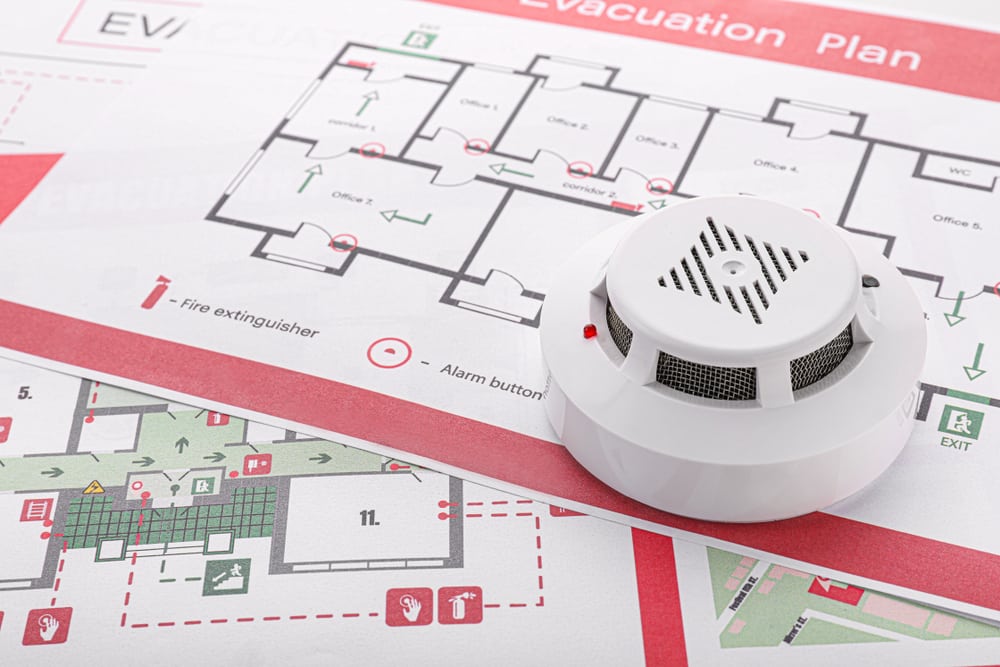Developing a Fire Evacuation Plan

Emergency preparedness and emergency response plans can help protect your team and your business. Having a comprehensive fire evacuation plan in place can help you avoid serious and even fatal injuries should disaster strike.
Working with a business disaster response and recovery expert can help ensure that your organization is prepared for every possible risk. Critical Path Solutions helps businesses and organizations of all sizes and types. Our professional disaster consultants conduct a comprehensive threat assessment and help you implement an emergency evacuation plan that will help you escape safely and recover as quickly as possible.
The Importance of Having a Business Evacuation Plan
Keeping your team safe at all times is imperative for any business or organization. Although the chances of having a major fire at your office or facility might feel remote, you must be prepared for all potential threats.
The four most pressing reasons for implementing a fire evacuation plan are as follows.
Protecting Your Team
Should disaster strike, you might believe that everyone will act on instinct and safely flee the premises. However, overwhelming situations such as fire, earthquake, flood, etc. can make even the most level-headed people panic. Once in panic mode, the ability to think clearly and logically can quickly dissipate.
Providing your team with a blueprint for evacuation, however, will give them a systematic plan to follow. When everyone is familiar with the plan, team members can help each other take the proper steps to ensure everyone’s safety.
Preserving Business Assets
Prior to a fire event, plans and processes should be in place to preserve and protect business assets. Important records should be backed up and, whenever possible, stored in a secured, offsite location. For smaller portable assets – like a cash box – assign a responsible party – and a backup person – to take charge of securing or removing them in the event of an emergency.
It is important to note that no one should ever put themselves at risk in exchange for easily replaceable (and typically insured) items. However, common-sense strategies for keeping valuable items in a fireproof cabinet or safe can certainly be incorporated into your disaster preparedness plans.
Avoiding Legal Liability
The last pressing reason for having a fire evacuation procedure in place is to protect you and your business from potential legal liability. If you fail to adopt a comprehensive disaster preparedness plan and someone is seriously injured or killed as a result, you will likely find yourself in litigation. You could even face potential governmental sanctions (for example, from OSHA) if you do not take all reasonable precautions to protect employees in the workplace.
Operational Recovery
After any type of disaster, getting your business back online is critical. Although many companies have plans in place that get everyone to safety, few organizations think beyond the day of the fire. Although this aspect of disaster preparedness might not technically be part of the fire evacuation planning itself it should be. You could quickly find yourself out of business if you don’t make actionable plans for business continuity under all potential scenarios.
For example, if your building is a total loss, what happens tomorrow? With a comprehensive disaster preparedness plan in place, your entire team will be ready for the next phase of operations.
What Should a Business Fire Escape Plan Include?
The specifics of any disaster preparedness or emergency evacuation plan will depend on the factors that are specific to your business and your facility. However, the basic components of a fire escape plan typically include the following:
Identified Tools & Resources
This might include fire extinguishers, alarm systems, emergency lighting, communications systems, rope ladders, or any other tools that could be necessary for getting everyone to safety.
Assigned Roles & Responsibilities
This includes establishing a chain of command and assigning individuals to handle specific tasks such as manning fire extinguishers, issuing directions, securing doors on the way out, conducting a head count to ensure everyone has been evacuated, etc.
Predetermined Escape Routes
You will typically need multiple established escape routes that consider the possibility of the primary and secondary routes being blocked. You must establish escape routes that can accommodate those with compromised mobility. As part of this component, you must also establish designated gathering points outside the facility.
Communication Plans
You will need multiple options for communicating with various members of your team both during and after the evacuation. Assign roles for reporting the emergency, for alerting all team members to evacuate, for following up with designated communication leaders, etc.
Once established it’s important to periodically review and update your fire escape plan as necessary.
Practicing & Reinforcing Your Fire Evacuation Plan
Even the most comprehensive fire evacuation procedures will be useless if you and your team have not practiced them sufficiently and recently enough to remember them should the time come.
Reinforcing your escape plan with ongoing practice drills will help ensure that everyone stays calm and follows the plan.
How an Emergency Evacuation Plan Expert Can Help
You can craft your own emergency evacuation plan. However, calling on the services of an expert can be invaluable.
Critical Path Solutions assists companies and organizations with disaster preparedness, recovery planning, and implementation. We understand the importance of planning and preparation that keeps your team safe and helps your business recover as quickly as possible after a disaster.
Contact us today for a personalized emergency preparedness evaluation and to learn more about the best way to implement your fire evacuation plan.
